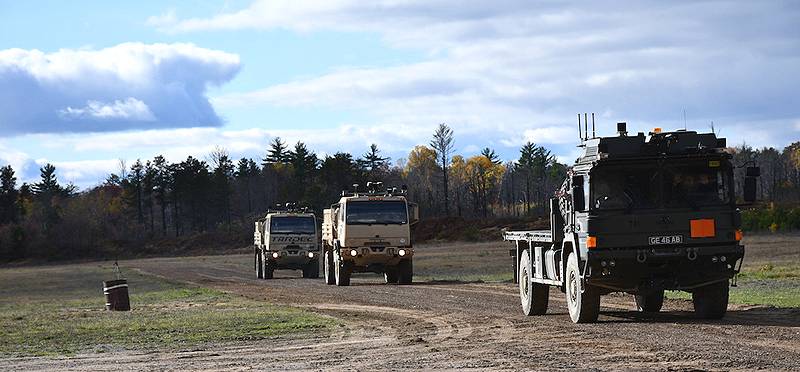Deserted convoys: the near future

The autonomous transport convoy is headed by a NH-60 truck, followed by two LMTV trucks.
The US-British team tested the technologies and concepts of autonomous supply.
As part of the demonstration tests CAAR (Coalition Assured Autonomous Resupply - guaranteed autonomous coalition supply), the British Laboratory of Defense Science and Technology (Dstl), American Army Armored Research Center (TARDEC), Arms Research and Development Center (ARDEC) tested the use of remote controlled vehicles (in the form of modified crew platforms) and unmanned aerial vehicles in logistic tasks. These demonstration runs took place at Camp Grayling, Michigan.
The test program included a test of the operation of a typical joint transport support column, as well as an autonomous coordinated support scenario “on the last mile” (on the ground and in the air), which was developed over the past three years.
According to the Dstl laboratory, the goal of an autonomous supply system “on the last mile” is to reduce the need for existing platforms and infrastructure, reduce risks and staff load, increase the efficiency of supply operations at a given pace and schedule and ensure a guaranteed supply of personnel on the front line. enhance maneuverability in a complex combat space.
The column operated in a master-slave configuration and moved at speeds up to 40 km / h; She was accompanied by two HMMWV armored vehicles with crews, equipped with Robotic Toolkit Software control stations. The leading platform was the British Army NH-60 truck manufactured by Rheinmetall MAN Military Vehicles GmbH (RMMV), followed by two American Army LMTV trucks (Light Medium Tactical Vehicle) manufactured by Oshkosh. All the trucks were equipped with the Lock Authentic Mobility Applique System (AMAS) autonomous mobility system developed by Lockheed Martin. AMAS is an optional multi-touch kit that is designed for integration with tactical wheeled vehicles and can be installed on existing vehicles.
In September, 2017 of the year TARDEC demonstrated AMAS technology by running a mixed convoy of army trucks and civilian vehicles on the Interstate 69 highway, which also ran in master-slave mode.
The technology used in AMAS combines sensors and control systems and is based on GPS, LIDAR laser locator, car radar and automotive sensors available on the market. The system includes a navigation unit that receives various signals, including GPS, and then, based on an arbitration algorithm that evaluates various incoming positioning data, provides location information.
The AMAS kit includes an antenna for the communication system, which, as a rule, is installed on the roof of the vehicle along with the LIDAR and GPS antenna. Inside the car are installed power steering system, steering wheel position sensor and sensors measuring the turning effort. Also installed inside the transmission and engine controllers, an electronically controlled braking system and electronic stability control. Code wheel position sensors are mounted on selected wheels, and a stereo camera in the upper part of the windshield. In the front and back of the machine, several short-range radars and car radars are installed; also installed side radars to eliminate blind spots. In the center of the machine is installed accelerometer / gyrotachometer stability control system.
The Polaris MRZR4x4 vehicle was used as a ground component of the autonomous "last mile" concept, which was remotely controlled by military personnel from the British Army Research and Testing Center. The car was traveling along a given supply route and was driven by a device in the form of a gaming tablet. Optionally, the crew car weighs 867 kg, develops speed 96 km / h and has a payload capacity of 680 kg.
Since so far this is a relatively new concept, there were backup drivers in the vehicles while the transport column was moving. However, their services were not requested, the cars passed the routes on their own, based on the real-time data or followed the GPS coordinates. It should be noted that the ground-based components in the CAAR demonstration process worked on a common radio network and were controlled from a tablet device.
Jeff Ratowski, CAAR project manager at the TARDEC Center, reported that a test plan scheduled for September-October 2018 of the year and September-October of 2019 of the year is currently being agreed. “The goal is to improve technology, increase machine speed and the level of integration of air and ground components.”
One of the goals of testing in 2018 is to work without backup drivers. “This is really the next step, the highest priority in the short term. We hope to start testing this technology in April of 2018, ”noted Ratowski.
“The six vehicles of the convoy will include two HMMWV escort armored vehicles, two NH60 trucks and two LMTV trucks. Offline capabilities will be demonstrated without backup drivers. The lead HMMV will route with intermediate points, and the remaining five cars will follow this route and there will not be a driver in any of them. ”
As the CAAR program evolves, the integration of the air and ground components will be tested in greater detail in order to demonstrate supply capabilities in real-world conditions.
Also participating in the demonstration Drones SkyFalcon by Gilo Industries and Hoverbike by Malloy Aeronautics.
Hoverbike is an electric quadcopter the size of a small car, capable of lifting 130 kg of cargo. It can fly at a speed of 97 km / h, the maximum height of the flight is 3000 meters. The drone is made of carbon fiber reinforced with Kevlar filled with foam. The electric motors of the device can be supplemented by an onboard generator to increase the duration of work. The system is controlled by the tablet. Hoverbike is designed for those customers who need to perform supply operations at low altitudes in areas with difficult terrain.
Materials used:
www.shephardmedia.com
www.army.mil
www.gov.uk
www.army-technology.com
www.wikipedia.org
Information